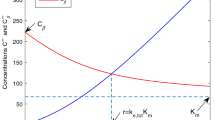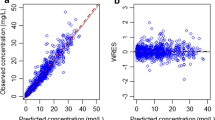Abstract
Clazosentan's potential QT liability was investigated in a thorough QT study in which clazosentan was administered intravenously as a continuous infusion of 20 mg/h immediately followed by 60 mg/h. Clazosentan prolonged the placebo-corrected change-from-baseline QT interval corrected for RR with Fridericia's formula (ΔΔQTcF) with the maximum QT effect occurring 4 h after the maximum drug concentration, apparently associated with vomiting. The delayed effect precluded the standard linear modeling approach. This analysis aimed at characterizing the concentration-QT relationship in consideration of RR-QT hysteresis, concentration-ΔΔQTcF hysteresis, and the influence of vomiting. Nonlinear mixed-effects modeling was applied to characterize pharmacokinetics and pharmacodynamics, i.e., ΔΔQTcF. Simulations were used to predict ΔΔQTcF for expected therapeutic dose used in Phase 3 clinical development. Correction for RR-QT hysteresis did not influence ΔΔQTcF to a relevant extent. Pharmacokinetics of clazosentan were best described by a linear two-compartment model. The delayed QT prolongation was characterized by an indirect-response model with loglinear drug effect. Vomiting had no statistically significant influence on QT prolongation despite apparent differences between subjects vomiting and not vomiting, probably since vomiting occurred mostly after the main QT prolongation. Following a simulated 3-h infusion of 15 mg/h of clazosentan, the upper bound of the predicted 90% CI for mean ΔΔQTcF was expected to exceed the 10-ms regulatory threshold of concern with maximum effect 3.5 h after end of infusion. TRN: NCT03657446, 05 Sep 2018.







Similar content being viewed by others
References
Juif P-E, Dingemanse J, Voors-Pette C, Ufer M (2020) Association between vomiting and QT hysteresis: data from a TQT study with the endothelin A receptor antagonist clazosentan. AAPS J 22:103. https://doi.org/10.1208/s12248-020-00485-6
ICH (2005) The clinical evaluation of QT/QTc interval prolongation and proarrhythmic potential for non-antiarrhythmic drugs. https://database.ich.org/sites/default/files/E14_Guideline.pdf
Garnett C, Bonate PL, Dang Q, Ferber G, Huang D, Liu J, Mehrotra D, Riley S, Sager P, Tornoe C, Wang Y (2018) Scientific white paper on concentration-QTc modeling. J Pharmacokinet Pharmacodyn 45:383–397. https://doi.org/10.1007/s10928-017-9558-5
Garnett C, Needleman K, Liu J, Brundage R, Wang Y (2016) Operational characteristics of linear concentration-QT models for assessing QTc interval in the thorough QT and phase I clinical studies. Clin Pharmacol Ther 100:170–178. https://doi.org/10.1002/cpt.361
Glomb P, Ring A (2012) Delayed effects in the exposure-response analysis of clinical QTc trials. J Biopharm Stat 22:387–400. https://doi.org/10.1080/10543406.2010.539309
Collins TA, Bergenholm L, Abdulla T, Yates JWT, Evans N, Chappell MJ, Mettetal JT (2015) Modeling and simulation approaches for cardiovascular function and their role in safety assessment. CPT Pharmacomet Syst Pharmacol 4:175–188. https://doi.org/10.1002/psp4.18
Fridericia LS (2003) The duration of systole in an electrocardiogram in normal humans and in patients with heart disease, 1920. Ann Noninvasive Electrocardiol 8:343–351. https://doi.org/10.1046/j.1542-474X.2003.08413.x
Franz MR, Swerdlow CD, Liem LB, Schaefer J (1988) Cycle length dependence of human action potential duration in vivo. Effects of single extrastimuli, sudden sustained rate acceleration and deceleration, and different steady-state frequencies. J Clin Invest 82:972–979. https://doi.org/10.1172/JCI113706
Lau CP, Freedman AR, Fleming S, Malik M, Camm AJ, Ward DE (1988) Hysteresis of the ventricular paced QT interval in response to abrupt changes in pacing rate. Cardiovasc Res 22:67–72. https://doi.org/10.1093/cvr/22.1.67
Malik M, Hnatkova K, Novotny T, Schmidt G (2008) Subject-specific profiles of QT/RR hysteresis. Am J Physiol Heart Circ Physiol 295:H2356–H2363. https://doi.org/10.1152/ajpheart.00625.2008
Malik M, Johannesen L, Hnatkova K, Stockbridge N (2016) Universal correction for QT/RR hysteresis. Drug Saf 39:577–588. https://doi.org/10.1007/s40264-016-0406-0
Malik M, Garnett C, Hnatkova K, Johannesen L, Vicente J, Stockbridge N (2018) Importance of QT/RR hysteresis correction in studies of drug-induced QTc interval changes. J Pharmacokinet Pharmacodyn 45:491–503. https://doi.org/10.1007/s10928-018-9587-8
Juif P-E, Henrich A, Krause A, Ufer M, Dingemanse J (2020) A thorough QT study with clazosentan, a selective endothelin A receptor antagonist. In: American Society for Clinical Pharmacology & Therapeutics (ASCPT) Annual Meeting. Houston, TX, United States of America
Malik M (2014) QT/RR hysteresis. J Electrocardiol 47:236–239. https://doi.org/10.1016/j.jelectrocard.2014.01.002
Jacquemet V, Cassani González R, Sturmer M, Dubé B, Sharestan J, Vinet A, Mahiddine O, Leblanc AR, Becker G, Kus T, Nadeau R (2014) QT interval measurement and correction in patients with atrial flutter: a pilot study. J Electrocardiol 47:228–235. https://doi.org/10.1016/j.jelectrocard.2013.11.002
Zisowsky J, Fuseau E, Bruderer S, Krause A, Dingemanse J (2014) Challenges in collecting pharmacokinetic and pharmacodynamic information in an intensive care setting: PK/PD modelling of clazosentan in patients with aneurysmal subarachnoid haemorrhage. Eur J Clin Pharmacol 70:409–419. https://doi.org/10.1007/s00228-014-1647-4
Lavielle M, Ribba B (2016) Enhanced method for diagnosing pharmacometric models: random sampling from conditional distributions. Pharm Res 33:2979–2988. https://doi.org/10.1007/s11095-016-2020-3
R Development Core Team (2019) R: a language and environment for statistical computing. R Foundation for Statistical Computing, Vienna, Austria. https://www.r-project.org/
Lixoft Inc (2019) Monolix Suite, Antony, France. http://lixoft.com/
FDA (2019) Guidance for industry: population pharmacokinetics. https://www.fda.gov/media/128793/download
Montgomery DC, Peck EA, Vining GG (2012) Introduction to linear regression analysis, 5th edn. Wiley, Hoboken
Power BM, Forbes AM, van Heerden PV, Ilett KF (1998) Pharmacokinetics of drugs used in critically ill adults. Clin Pharmacokinet 34:25–56. https://doi.org/10.2165/00003088-199834010-00002
Sarma JS, Venkataraman SK, Samant DR, Gadgil U (1987) Hysteresis in the human RR-QT relationship during exercise and recovery. Pacing Clin Electrophysiol PACE 10:485–491. https://doi.org/10.1111/j.1540-8159.1987.tb04510.x
Minocha M, Li H, Chiu Y-L, Carter D, Othman AA (2019) Models of variability and circadian rhythm in heart rate, blood pressure, and QT interval for healthy subjects who received placebo in phase I trials. Clin Transl Sci 12:470–480. https://doi.org/10.1111/cts.12640
Piotrovsky V (2005) Pharmacokinetic-pharmacodynamic modeling in the data analysis and interpretation of drug-induced QT/QTc prolongation. AAPS J 7:E609–E624. https://doi.org/10.1208/aapsj070363
van Giersbergen PLM, Treiber A, Dingemanse J (2009) In vitro and in vivo pharmacokinetic characteristics of clazosentan, an intravenous endothelin receptor antagonist, in humans. Int J Clin Pharmacol Ther 47:169–177. https://doi.org/10.5414/cpp47169
Derendorf H, Meibohm B (1999) Modeling of pharmacokinetic/pharmacodynamic (PK/PD) relationships: concepts and perspectives. Pharm Res 16:176–185. https://doi.org/10.1023/A:1011907920641
Thai H-T, Mentré F, Holford NHG, Veyrat-Follet C, Comets E (2014) Evaluation of bootstrap methods for estimating uncertainty of parameters in nonlinear mixed-effects models: a simulation study in population pharmacokinetics. J Pharmacokinet Pharmacodyn 41:15–33. https://doi.org/10.1007/s10928-013-9343-z
Veyssier P, Voirot P, Begaud B, Funck-Brentano C (2006) Cardiac tolerance of moxifloxacin: clinical experience from a large observational French study in usual medical practice (IMMEDIAT study). Med Mal Infect 36:505–512. https://doi.org/10.1016/j.medmal.2006.09.001
Padrini R, Gusella M, Al Bunni M, Piovan D, Zordan R, Magnolfi G, Maiolino P, Ferrari M (1997) Tolerance to the repolarization effects of rac-sotalol during long-term treatment. Br J Clin Pharmacol 44:463–470. https://doi.org/10.1046/j.1365-2125.1997.t01-1-00604.x
Fenichel RR, Malik M, Antzelevitch C, Sanguinetti M, Roden DM, Priori SG, Ruskin JN, Lipicky RJ, Cantilena LR, Force IAT (2004) Drug-induced torsades de pointes and implications for drug development. J Cardiovasc Electrophysiol 15:475–495. https://doi.org/10.1046/j.1540-8167.2004.03534.x
van Giersbergen PLM, Dingemanse J (2007) Tolerability, pharmacokinetics, and pharmacodynamics of clazosentan, a parenteral endothelin receptor antagonist. Eur J Clin Pharmacol 63:151–158. https://doi.org/10.1007/s00228-006-0117-z
Funding
This study was funded by Idorsia Pharmaceuticals Ltd.
Author information
Authors and Affiliations
Contributions
All authors contributed to study design, analysis, and interpretation. AH performed the analysis and wrote the manuscript. All authors read and approved the final manuscript.
Corresponding author
Ethics declarations
Conflict of interest
All authors are employees and shareholders of Idorsia.
Research involving human participants, their data or biological material
All procedures performed in studies involving human participants were in accordance with the ethical standards of the institutional and/or national research committee and with the 1964 Helsinki Declaration and its later amendments or comparable ethical standards. The protocol was approved by the Ethics Committee (Medisch Ethische Toetsings Commissie, Assen, The Netherlands).
Informed consent
Informed consent was obtained from all individual participants included in the study prior to any study procedure.
Additional information
Publisher's Note
Springer Nature remains neutral with regard to jurisdictional claims in published maps and institutional affiliations.
Supplementary information
Below is the link to the electronic supplementary material.
Rights and permissions
About this article
Cite this article
Henrich, A., Juif, PE., Dingemanse, J. et al. PK/PD modeling of a clazosentan thorough QT study with hysteresis in concentration-QT and RR-QT. J Pharmacokinet Pharmacodyn 48, 213–224 (2021). https://doi.org/10.1007/s10928-020-09728-7
Received:
Accepted:
Published:
Issue Date:
DOI: https://doi.org/10.1007/s10928-020-09728-7




